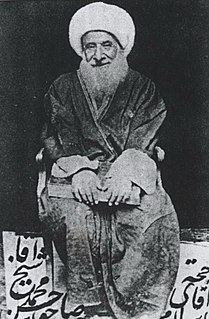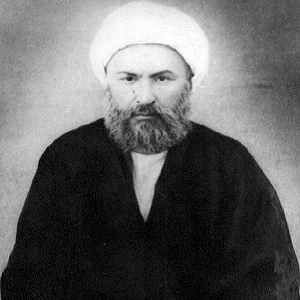
Kargil district is one of the two districts comprising Ladakh, an Indian-administered union territory. It is bounded by the Indian-administered union territory of Jammu and Kashmir in the west, Pakistani-administered Gilgit–Baltistan in the north, Ladakh's Leh district in the east, and the Indian state of Himachal Pradesh in the south. Encompassing two historical regions known as Purig and Zanskar, the district lies to the northwest of the Great Himalayas and encompasses the majority of the Zanskar Range. Its population inhabits the river valleys of the Dras, Suru, Kartse, Wakha, and Zanskar.

Mohammad-Ali Taskhiri was an Iranian cleric and diplomat. During the 1980s, Taskhiri served as the Iranian representative to the Organisation of the Islamic Conference and was involved in promoting Iranian interests during the height of the Iran–Iraq War.

Grand Ayatollah Sheikh Mirza Jawad Kubar Tabrizi was an Iranian Shia marja'.

Grand Ayatollah Sheikh Murtadha al-Ansari al-Tostari (1781-1864),, also transliterated as Mortaza Ansari Shushtari, was a Shia jurist who "was generally acknowledged as the most eminent jurist of the time."
The five Martyrs were five ulama of Shi'i Islam, living in different spans of history, who were executed by their respective regimes. The Shia remember them by the term Five Martyrs.
Kitab al-Makasib or Makasib is a two-volume Twelver Shi'ah legal manual of Islamic commercial law written on Fiqh by Morteza Ansari. It remains a key textbook in the modern Hawza and has been the subject of numerous commentaries. Makasib and the notable work of Akhund Khorasani, Kefayah al-osul, are taught in advanced classes at the seminaries. This book is one of the resources for the examination of the Assembly of Experts.

Syed Safdar Hussain Najafi was a scholar and religious leader.

Grand Ayatollah Sayyid Mohammad Hadi Milani was an Iraqi-Iranian marja'.

Hujjatul Islam Sheikh Muhammad Mussa Shariefi was a senior Islamic Twelver Shia religious scholar/alim from the Kargil district of Ladakh. He was renowned for his philosophical and mystical Friday prayer sermons which were always attended by thousands of people from the length and breadth of Kargil. He became the Imam e Jumu'ah of Jamia Masjid Kargil after the death of the immensely popular Shia mystic and scholar, Hujjat ul Islam wal Muslimeen Aqa Sheikh Khanteypa. He gained immense popularity for his usage of the local dialect for delivering his Friday sermons.

Eliezer Joldan (1916-2001) was the first trained graduate to profess teaching as a profession in Ladakh. He was born in 1916 to Jonathan Tharchin Joldan and Chamnyet. He got his bachelor's degree in education from the Punjab University, Lahore. He died at the age of 85 at Leh. The Govt. Degree College at Leh is named after him. His students includes top political leaders, doctors, scholars and other intelligentsia of Ladakh on 23 June 2001. He would always prefer the traditional Ladakhi Goncha over western pants and shirts.
Jamiat-ul-Ulama Isna Asharia, Kargil-Ladakh is a socio-religious institution of Kargil, Ladakh in Indian Administered Kashmir catering mainly to the socio-religious needs of the region. It was founded in 1953, and has jurisdiction over Ulemas of the region and deputes them to villages where they guide people in religious matters, run Madrasas and works as prayer monitors. It also organises the Friday prayers in the Kargil town.
Sheikh Muhammad Hussain Zakiri was a Shia Islamic religious scholar/alim from Kargil, Indian Administered Kashmir and the founder of Imam Khomeini Memorial Trust, Kargil. He was deeply influenced by Islamic Revolution of Iran and its founder Ayatollah Ruhollah Khomeini. In 1989 Zakiri established the trust named after Ayatollah Khomeini which played a key role, not only in educational and social sectors, but gave a new direction and meaning to politics of this most neglected region of the state. He was a prominent poet and scholarly person having published many books and poetic collections.

Grand Ayatollah Sheikh Muhammad-Hasan al-Najafi, also known as Sahib al-Jawahir, was a prominent Shiite religious authority and author. He was most known for his books of Jawahir al-Kalam Fi Sharh Shara’i‘ al-Islam, a 42-volume work on fiqh.

Mohammad Aghazadeh Khorasani (Persian: محمد آقازاده خراسانی; born 1877 in Najaf, Iran) was a Shia cleric from Iran, known for his scientific work published under pseudonyms such as Ayatollah Aghazadeh, Ayatollah Aghazadeh Najafi, or Ayatollah Aghazadeh Khorasani.

Grand Ayatollah Mujaddid Mirza Abu Muhammad Mu'iz al-DinMuhammad-Hassan al-Husayni al-Shirazi, better simply known as Mirza Shirazi, was an Iraqi-Iranian Shia marja'.
Burhanuddin Ulakan Pariaman, also known as Sheikh Burhanuddin Ulakan, was an Islamic cleric (ulama) from the Minangkabau region. He is regarded as the pioneer of Islamic propagators in West Sumatra. He is also known as a commanding figure of the Islamic movements against the Dutch colonization. Regarding his Islamic belief, he was a Sufi murshid belonging to the Shattari tariqa based in Minangkabau region.

Grand Ayatollah Mulla Muhammad Ashrafi was a leading Iranian Shia Marja' in Mazandaran; Iran from roughly 1839 to his death in 1898. His Father Mulla Muhammad Mehdi was one of the Ulama of Behshahr. He was his first teacher and thought him primary cleric subjects and tried to nurture him with shia knowledge and Ahl Al-Bait friendship and love.

Grand Ayatollah Sayyid Abd al-A'la al-Musawi al-Sabziwari was an Iranian-Iraqi Shia marja'. He is regarded as one of the most influential grand religious authorities, and a contemporary of Abu al-Qasim al-Khoei.

Ayatollah Sayyid Muhammad-Kadhim al-Husayni al-Modarresi was an Iranian-Iraqi Shia scholar and mystic. He was a prominent teacher at the seminaries of Mashhad and Karbala, teaching Islamic philosophy. He held the Quranic exegesis chair of the Karbala seminary and taught aqaed in the al-Hindiya and al-Badkubeh schools.
Ayatollah Sheikh Muhammad-Baqir al-Irawani is an Iraqi Shia scholar, religious authority, and poet.













